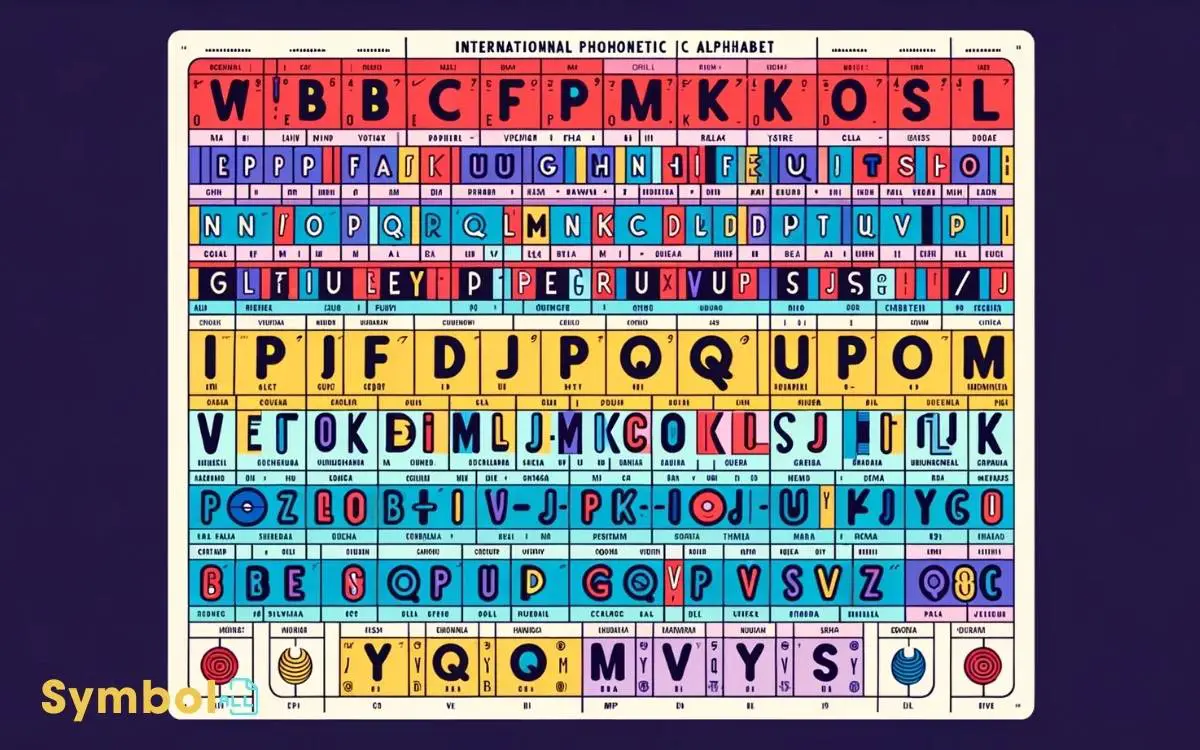Color Vowel Chart With Ipa Symbols: Find Out Here!
The Color Vowel Chart with IPA symbols integrates colors and precise IPA symbols to streamline your understanding of vowel sounds.
Each color represents a specific vowel sound, simplifying recognition and enhancing memory retention.
This dual-coded system not only improves your phonetic awareness but also provides you with the tools for accurate pronunciation across different languages.
By systematically arranging vowels based on articulatory features, it bridges the gap between phonetic theory and practical application.
Mastering these nuances enables a deeper comprehension of subtle phonetic differences, equipping you for better pronunciation. As you explore further, you’ll uncover valuable insights into effective language learning.

Key Takeaway
Color Vowel Chart with IPA Symbols and Pronunciation Examples
| Vowel Sound | Color Name | IPA Symbol | Example Word |
|---|---|---|---|
| ee | Green | /iː/ | “see” |
| i | Silver | /ɪ/ | “sit” |
| ae | Black | /æ/ | “cat” |
| a | Olive | /ɑː/ or /ɒ/ | “father”, “hot” |
| e | Red | /ɛ/ | “bed” |
| u | Blue | /ʊ/ | “put” |
| oo | Wood | /uː/ | “food” |
| er | Purple | /ɜːr/ | “bird” |
| ai | White | /aɪ/ | “my” |
| oi | Choice | /ɔɪ/ | “boy” |
| ou | Brown | /aʊ/ | “cow” |
| aw | Olive | /ɔː/ | “all” |
| ay | Gray | /eɪ/ | “say” |
Understanding the Color Vowel Chart
The Color Vowel Chart represents a unique approach, integrating both color and the International Phonetic Alphabet (IPA) symbols, to enhance your understanding of English vowel sounds.
By associating distinct hues with specific vowel sounds, it leverages your brain’s natural inclination for color recognition to facilitate quicker, more intuitive learning.
Each color corresponds to a particular vowel sound, sidestepping the ambiguity often encountered with traditional phonetic teaching methods.
This visualization not only simplifies the recognition and reproduction of sounds but also aids in memory retention.
As you explore the chart, you’ll uncover its systematic arrangement, which categorically groups vowels based on their articulatory features.
This structured layout fosters a deeper, analytical comprehension of vowel sounds, streamlining your path to pronunciation proficiency.
The Role of IPA Symbols
Integrating IPA symbols into the Color Vowel Chart greatly enhances your phonetic awareness, allowing for a more precise identification and production of English vowel sounds.
The International Phonetic Alphabet (IPA) provides a vital set of symbols for each distinct sound, making it an essential tool for linguists and language learners alike.
By correlating specific colors with corresponding IPA symbols, you’re equipped with a dual-coded system.
This not only simplifies the learning process but also facilitates a deeper understanding of subtle phonetic nuances.
Through this integration, you’re able to visualize and articulate vowels with increased accuracy, bridging the gap between phonetic theory and practical application.
The role of IPA symbols, as a result, transcends mere transcription; they serve as foundational elements that enhance linguistic competence.
Decoding Vowel Sounds
Building on your understanding of IPA symbols, it’s now time to tackle the task of decoding vowel sounds with precision and accuracy.
Decoding involves systematically breaking down the sounds that vowels represent in various languages. Each IPA symbol corresponds to a specific vowel sound, regardless of spelling variations in written language.
It’s vital to grasp the subtle distinctions between these symbols to accurately pronounce words from different languages. For instance, the symbol /i/ represents the vowel sound in “see,” distinct from /ɪ/, as in “sit.”
Mastery of these nuances enables you to read IPA transcriptions effectively, thereby improving your pronunciation skills. Paying close attention to each symbol’s unique articulatory features is paramount for this process.
Color Associations Explained
Color associations, a crucial aspect of the Color Vowel Chart, greatly enhance your ability to remember and reproduce vowel sounds accurately by linking each sound with a specific color.
This method leverages the psychological impact of color on memory and perception, providing a mnemonic device that simplifies the complex process of vowel pronunciation.
Each color selected correlates with the acoustic characteristics of the vowel sound it represents, making it easier for you to internalize these sounds.
For instance, brighter colors often symbolize higher, front-placed vowel sounds, whereas deeper shades are used for lower, back-placed vowels. This connection between colors and vowel placement highlights the fascinating interplay between visual and auditory perception. Such associations can vary across cultures, much like how the South African flag color meanings represent different symbolic interpretations tied to the country’s history and unity. Exploring these links broadens our understanding of how sensory stimuli can evoke nuanced emotional and cognitive responses.
This strategic pairing between color and sound facilitates a more intuitive learning experience, enabling you to visualize and thereby better articulate the nuanced differences in vowel sounds.
Practical Applications
In practical terms, you’ll find the Color Vowel Chart instrumental in enhancing your pronunciation skills through targeted exercises and real-world applications.
By integrating the chart with IPA symbols, you’re equipped to dissect and understand the subtle nuances in vowel sounds across various languages.
This methodological approach facilitates a shift from theoretical knowledge to practical proficiency, enabling you to mimic authentic accents more accurately.
Utilizing this tool, you can systematically practice vowel sounds by associating them with specific colors, thereby creating a visual and auditory linkage that improves recall and articulation.
Additionally, it serves as a reference point for continuous improvement, allowing you to track progress and identify areas needing further refinement.
Essentially, the Color Vowel Chart with IPA symbols becomes an indispensable asset in your linguistic toolkit.
Challenges and Solutions
You’ll encounter pronunciation variability issues when applying the Color Vowel Chart with IPA symbols in diverse linguistic contexts.
To address this, it’s important to integrate adaptive strategies that can accommodate a wide range of phonetic nuances.
Enhancing chart accessibility requires deploying digital platforms that offer interactive and user-friendly interfaces, ensuring learners of all backgrounds can efficiently navigate and utilize the tool.
Pronunciation Variability Issues
Addressing pronunciation variability issues requires a nuanced understanding of phonetic differences and their impact on communication.
You’ll encounter variations in pronunciation due to regional accents, individual speech patterns, and second language influences.
These disparities can greatly affect how vowel sounds are produced and perceived, posing challenges in both learning and teaching pronunciation.
| Challenge | Solution |
|---|---|
| Accent variation | Use IPA symbols for precise representation |
| Individual speech patterns | Tailor teaching to address specific needs |
| Second language influence | Incorporate comparative phonetic analysis |
Chart Accessibility Enhancements
While addressing pronunciation variability through the use of IPA symbols offers a structured approach, enhancing the accessibility of the Color Vowel Chart presents its own set of challenges and solutions.
You must address visual impairment issues, requiring essential text descriptions for the color-coded aspects and symbols.
Implementing screen reader-friendly formats is essential, as is ensuring that color contrasts meet accessibility standards for those with color vision deficiencies.
Additionally, providing audio examples alongside visual representations can bridge understanding gaps.
To tackle language barriers, multilingual descriptions of each vowel sound can enhance comprehension across diverse user bases.
Tips for Teachers and Learners
Implementing the Color Vowel Chart effectively requires teachers and learners to grasp its nuances and apply specific strategies for pronunciation improvement.
You must initially familiarize yourself with the IPA symbols and their corresponding vowel sounds.
It’s essential to understand that each color represents a unique vowel sound, aiding in the visualization of pronunciation patterns. Practice by isolating sounds, then gradually integrate them into words and sentences.
Employ auditory discrimination exercises to sharpen your ability to distinguish between subtle sound differences.
Regularly recording your pronunciation and comparing it against native speakers can provide valuable feedback.
For teachers, incorporating interactive activities that encourage vocal experimentation within a supportive environment enhances learner engagement.
Advancing Pronunciation Skills
To progress your pronunciation skills, it’s crucial to delve further into the nuanced aspects of the IPA and the Color Vowel Chart, focusing on the precise articulation of sounds.
Delving deeper, consider the following:
- Analyze vowel length and tension: Distinguishing between long and short vowels, as well as tense versus lax, can greatly impact pronunciation accuracy.
- Master consonant clusters: Practice blending consonants smoothly, especially in complex clusters, to improve fluency.
- Incorporate prosody: Understanding and applying the rhythm, stress, and intonation patterns of the language can vastly enhance comprehensibility.
- Utilize minimal pairs: Regularly practice with minimal pairs to refine your ability to distinguish and produce subtle sound differences.
Conclusion
To sum up, delving into the world of the color vowel chart with IPA symbols is like deciphering the hidden code of English pronunciation.
It’s not just studying; it’s venturing on a linguistic treasure hunt where each vowel sound shines like a valuable gem.
By mastering this chart, you’ll not simply articulate words; you’ll illustrate them in the air with precision.
So, embrace this challenge, for it’s your pass to becoming a pronunciation wizard, transforming puzzling sounds into a symphony of clarity.






